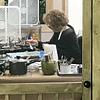Take a photo of a barcode or cover
I'm in two minds about this book: on one side I loved Violet and her struggle for independence, on the other side I found it a bit boring as there're tons of details that slow the pace.
It's a character driven book and, even though I found the cast of characters well written and likeable, I wished some more actions.
I liked the style of writing and the well researched historical background.
Not my cup of tea.
Many thanks to the publisher and Edelweiss for this ARC, all opinions are mine.
It's a character driven book and, even though I found the cast of characters well written and likeable, I wished some more actions.
I liked the style of writing and the well researched historical background.
Not my cup of tea.
Many thanks to the publisher and Edelweiss for this ARC, all opinions are mine.
Violet’s excitement over learning a new skill intrigued me - until she gave it up when her life took a turn. So much for that. Arthur’s passion for bell ringing felt more sincere and is lovely. Beyond that, I feel the story is one that’s been told already over and over. I’m not taken with this book.
emotional
hopeful
reflective
sad
slow-paced
Strong character development:
No
Loveable characters:
Complicated
Diverse cast of characters:
Complicated
Flaws of characters a main focus:
Yes
This is the only TC I've read except TGWTPE. It's good. I live near Winchester and it's always interesting to read a book set somewhere you know quite well. The story, with its combination of catherdral detail, bellringing detail, needlepoint detail and 'surplus women' detail is good, although some of the dialogue is a bit weirdly formal. Violet, with her awkwardly constrained life, contained sorrow and awful mother, is a sympathetic protagonist, and once again one is infinitely grateful not to have been born any earlier than one was.
lighthearted
relaxing
slow-paced
I read this for the BookTube Prize semifinals. You can see my full thoughts here: https://youtu.be/DxfzyvQ2ixY
This book is about violet, a spinster in between the two world wars that decides to work and live independently, and learns how to embroider in a group in the cathedral. It explores the pain of WWI and the fear of Hitler. It shows a feminist look at what it was to be a spinster, since there were many due to all the men that died at war. And it looks at women’s relationships and friendships in the embroidery group. It was ok, enjoyable but surface level.
hopeful
lighthearted
relaxing
While I appreciated the historic details of this story and the insight into the challenges faced by single “surplus” women in post WWI, there isn’t much of a plot here. It’s more of a quiet look at how one woman, Violet, tries to have an independent life for herself, rather than be forced to live as her widowed mother’s caretaker and companion. I did enjoy it nonetheless but it might not appeal to those looking for a faster paced story.
More like 3.5. I found the beginning a bit slow but the ending was great. Couldn't really relate much to the character but still rooted for her throughout.
slow-paced
2.5 stars.
There were parts of this book that I enjoyed, but overall, this was pretty much a miss for me. I personally am not a big fan of historical fiction set during WWI, the interwar years, or WWII (particularly in Europe) as I really just do not find that to be the most interesting parts of history, and this one played heavily into that. I also really did not enjoy our main character Violet—her independence, at times, felt more self-serving than I thought was really enjoyable. I also found the ending to be entirely out of character and just...an odd choice on the author’s part, to say the least. I did enjoy her friend Gilda’s storyline, and also enjoyed Louisa Pesel as a character.
The level of research into the historical details of the period was also enjoyable, particularly the parts wherein Violet goes on her walking holiday (honestly, had the whole book been about that, I may have enjoyed it more). I will say, however, that sometimes this book felt a bit too retrospective with regards to Nazi Germany, especially given that it was only 1932. For example, towards the end of the novel, one character becomes almost abrasive with concern regarding an embroidery pattern that he believes features a swastika (it features the English floral design that the swastika was in part based on, a fylfot). While obviously there were people in 1932/33 who must have been concerned about the rise of Hitler in Germany, I just did not find it believable that they would be making the same strong associations of Nazi propaganda that we would give our knowledge of the horrors of the Nazis were mainly uncovered during and after the war, which began a full six years after this novel is set.
There were parts of this book that I enjoyed, but overall, this was pretty much a miss for me. I personally am not a big fan of historical fiction set during WWI, the interwar years, or WWII (particularly in Europe) as I really just do not find that to be the most interesting parts of history, and this one played heavily into that. I also really did not enjoy our main character Violet—her independence, at times, felt more self-serving than I thought was really enjoyable. I also found the ending to be entirely out of character and just...an odd choice on the author’s part, to say the least. I did enjoy her friend Gilda’s storyline, and also enjoyed Louisa Pesel as a character.
The level of research into the historical details of the period was also enjoyable, particularly the parts wherein Violet goes on her walking holiday (honestly, had the whole book been about that, I may have enjoyed it more). I will say, however, that sometimes this book felt a bit too retrospective with regards to Nazi Germany, especially given that it was only 1932. For example, towards the end of the novel, one character becomes almost abrasive with concern regarding an embroidery pattern that he believes features a swastika (it features the English floral design that the swastika was in part based on, a fylfot). While obviously there were people in 1932/33 who must have been concerned about the rise of Hitler in Germany, I just did not find it believable that they would be making the same strong associations of Nazi propaganda that we would give our knowledge of the horrors of the Nazis were mainly uncovered during and after the war, which began a full six years after this novel is set.





